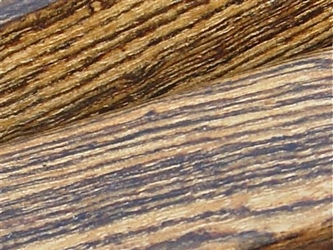 |
Bocote
Bocote is a stiff medium weight exotic wood from the American tropics that delivers a powerful yet surprisingly warm tone.
Bocote is a fairly oily wood highly prized for its dramatic wild figuring. The bold dark streaks sometimes form concentric circles which give Bocote its defining look and distinctive appearance.
The wood is quite resistant to decay and insect attack.
Bone Rattling Facts
Bocote is an exceptionally hard wood prized for eye-catching musical instrument fingerboards. It also holds a superb reputation as a guitar sound board that vibrates an instrument with abundance.
Because the hardness is tempered by a medium weight and density, these bones produce a marvelously strong warm tone.
Cool Facts
Bocote has a moderate scent when being worked that resembles dill pickles. Goose calls made from bocote are reported to have a natural rasp and mellow tone.
Figures below are approximate (but pretty darn close)
Tonality
Can't Decide Which Bones to Choose?
Check out this handy guide: Bone FAQs
Scroll down for technical Bocote facts...
|
|
Bocote Facts
Scientific Name
Cordia elaeagnoides (aka: cordia gerascanthus, cordia alliodora)
Other Names
Amapa asta (Mexico)
Anacahuite
Barcino
Baria (Cuba)
Bocote
Bois de rose
Canalete
Canalete (Colombia, Venezuela)
Cordia
Cupane
Cype
Ecuador laurel
Freijo
Laurel
Laurel de costa
Laurel Laurel de costa
Laurel negro
Light American
Loro negro (Argentina)
Louro pardo (Brazil)
Mexican rosewood
Peterebi
Salmwood
Solera
Grain
The grain pattern alternates from golden to dark brown giving Bocote its distinctive look. Bocote's grain can vary from straight to interlocked with nice contrast that often reveals a birdseye effect and other striking figures.
Texture
Typically medium to small pores with a medium texture and naturally oily or waxy feel.
Luster
Polishes to a high luster.
Heartwood Color
Golden brown to dark brown
(Honey Nougat and Chocolate Pulled Taffy)
The heartwood ranges from light golden brown to dark brown with eye-catching striations and figuring. Darkens with age.
Sapwood Color
Sharply demarcated gray or yellowish sapwood.
Aroma
Mild dill-like fragrance.
Woodworking
Easy to work with and finishes very smoothly. Moderately high natural gloss. Polishes well with wax or polyurethane. Birdseyes and other figuring not a problem. Fairly high level of natural oils but usually glues well. Bocote is sometimes used as a substitute for mahogany, teak or walnut. Resembles Cocobolo without an orange tint.
Environmental Profile
Not known where timber is obtainable from sustainably managed or other environmentally responsible sources. Reportedly logged by hand with mules using selective cutting method from sustainable and responsible site in Southern Mexico.
Distribution
Indigenous to Mexico, Central America and the West Indies. Ranges from Mexico to Brazil. Also grows in Florida.
Tree Data
The small to large tree grows from 65 to 100 feet (20 to 30 m) tall with a diameter from 3 to 5 feet (1 to 1.5 m). Sparsely distributed over wide range in tropical dry zones.
|
|
|